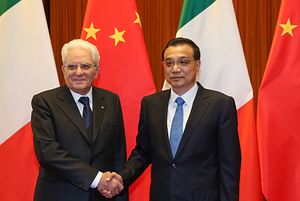In late February, both the President of the Italian Republic, Sergio Mattarella, and French Prime Minister, Bernard Cazeneuve, paid state visits to China and met with Chinese President Xi Jinping and Premier Li Keqiang. During the separate meetings, all four leaders praised Sino-European cooperation and called for more exchanges between the two regions. Several bilateral agreements were signed, including a Sino-French deal on nuclear energy and a Sino-Italian scientific agreement on spatial cooperation.
Mattarella and Cazeneuve are strong supporters of free trade and their visits to China illustrate Europe’s willingness to develop stronger ties with China. Xi, at the World Economic Forum in Davos, firmly supported European integration and called on Europe and China to fight against trade protectionism. U.S. President Donald Trump’s disruptive diplomacy and the abandonment of the Trans-Pacific Partnership may be an opportunity for Europe to become a major partner for China. The Chinese “Belt and Road” initiative may bring together the two regions, but both China and European countries need to slightly redefine their approaches to “One Belt, One Road” in order to increase their exchanges.
During their visits, both Mattarella and Cazeneuve showed interest in the “One Belt, One Road” strategy developed by China. However, one can bemoan the lack of coordination between the two European neighbors. Both countries presented their own assets for the completion of the new Silk Road. Thus, Mattarella emphasized the quality and locations of the Italian ports of Genoa and Trieste to reach the core of Europe, and Cazeneuve attended the arrival in Wuhan of a freight train coming from Lyon, France. Although the Italian president and the French premier visited China at the same time, no common meetings or shared events were held. The French and Italian heads of state and government were focused on a bilateral approach of relations with China, but the success of “One Belt, One Road” largely depends on the participants’ ability to manage multilateral projects.
Of course, China could take advantage of a divided Europe, as Brexit and the European appetite for Chinese investments will obviously strengthen Beijing’s bargaining powers. However, China should not abuse its dominant position on Europe, in order to ease the completion of the “Belt and Road.”
First, the Chinese and European powers do not use the same time scale, and this may impact Europe’s involvement in the “One Belt, One Road” strategy. Contrary to China, European governments, because of regular elections, are driven by rapid results in terms of investments and job creation. This means that European countries are likely to be heavily involved in the “Belt and Road” initiative only if they can foresee results in the next couple of years.
Secondly, it is in Beijing’s interests that Europeans benefit from the “One Belt, One Road” project. Europe is shaken by political turmoil, illustrated by the rise of Euroskeptism and protectionism, boosted by Trump’s election as president. France’s far right movement “Front National” (National Front), the French leftist party “La France Insoumise” (Unsubmissive France), and Italy’s “Movimento Cinque Stelle” (Five Star Movement), all call for more protectionism. Both France and Italy suffered from high trade deficits with China in 2015 (29 and 18 billion Euros, respectively). In 2013, France’s President Francois Hollande already declared that this deficit was unsustainable. If EU-China trade becomes more unbalanced, European states will be pressured further by public opinion to close their borders to Chinese products.
In order to make the new EU-China partnership a reality, new dimensions should be added to the “Belt and Road” initiative, so that both regions can enjoy the results of “One Belt, One Road” rapidly.
As mentioned by Alice Rezkova, more attention should be paid to the digital version of the“Belt and Road,” and Sino-European cooperation should not be restricted to traditional industries but also be open to innovative sectors. There are still too many barriers that prevent European small and medium-sized enterprises from entering the Chinese market. For example, European companies still need to obtain licenses to access China’s online retail market. They also worry about copyrights and patent protection. These measures do not require large investments or infrastructures, but they do need a new “software” of EU-China relations focusing on small projects. Only when European small and medium-sized enterprises are convinced of the opportunities offered will European states be likely to coordinate their policies and partially fund the infrastructures for “One Belt, One Road.”
To make the new Silk Road effective, China and Europe need to develop a common “lingua franca” so that companies can operate easily and safely in both regions.
Dr. Sebastien Goulard works at Cooperans, a public affairs consultancy specialised in governance and Sino-European relations. Goulard completed a Ph.D. in economic and social development studies from EHESS (Ecole des Hautes Etudes en Sciences Sociales, ‘School for Advanced Studies in the Social Sciences’), Paris.
































